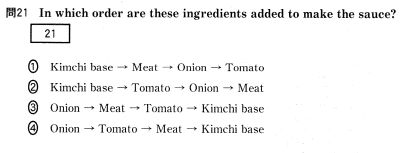The world is full of countless foods and ways of eating them. It’s impossible to keep track of them all. I was surprised to discover salty watermelons, just as other people were surprised by my preference of putting peanut butter on waffles.
Such an incident happened on 19 January when a Japanese test maker unknowingly confused thousands of university entrance exam students with a recipe for a meat sauce calling for a “delicious kimchi base.”
As the prospective students were challenging themselves to English listening comprehension questions, they listened to an instructor read How to Make Meat Sauce. During this they would answer a series of multiple choice questions.
The speech touched upon phrases like “using a kimchi base is delicious”, which understandably confused the listeners of this typically Italian recipe. Confirming that the students weren’t hearing things, question 21 reads:
Without hearing the script, we’d hazard a guess that third option – carameling the onions then adding browned meat followed by tomatoes and kimchi – seems like the best method. But, by calling it a “kimchi base”, number one would have to be the correct answer… right?
One Twitter user decided to put the test to the test and make their own kimchi meat sauce pasta. After uploading a photo of it on Twitter its popularity skyrocketed, racking up around 16,000 retweets.
According to the maker “it’s by no means disgusting” but other commenters beg to differ saying, “just one bite is enough to make you stop eating.”
Never having had kimchi meat sauce before, it doesn’t seem like such a bad idea if the balance is right. In fact, condiment maker Moranbong has their own Kimchi Meat Sauce recipe which doesn’t look half-bad at all.
However, the Moranbong recipe makes no reference to a “kimchi base.” According to them you should cook the meat first and then add kimchi and onion. The tomato should be added last of the four. I’m going to be up all night thinking about that question now…
Source: Twitter @core2duoxeon, Eastward Highschool via Entabe (Japanese)


 Kimchi cocktail offers a taste of Korea that no Korean would actually endorse
Kimchi cocktail offers a taste of Korea that no Korean would actually endorse Youtube channel Make Food. Eat Food. will inspire you with creations based on Asian cuisine
Youtube channel Make Food. Eat Food. will inspire you with creations based on Asian cuisine Beautiful red soy sauce from Japan uses no artificial colors, tastes like nothing else
Beautiful red soy sauce from Japan uses no artificial colors, tastes like nothing else Make your tummy happy, eat a kimchi yogurt rice bowl today
Make your tummy happy, eat a kimchi yogurt rice bowl today Hamburg and Hamburg Shibuya: A Japanese restaurant you need to put on your Tokyo itinerary
Hamburg and Hamburg Shibuya: A Japanese restaurant you need to put on your Tokyo itinerary Hello, cosmetics! Clinique teams up with Hello Kitty this summer for first-time collaboration
Hello, cosmetics! Clinique teams up with Hello Kitty this summer for first-time collaboration Demon Slayer: Kimetsu no Yaiba gets new roller coaster attractions and food at Universal Studios Japan
Demon Slayer: Kimetsu no Yaiba gets new roller coaster attractions and food at Universal Studios Japan How to order snacks on a Shinkansen bullet train in Japan
How to order snacks on a Shinkansen bullet train in Japan High-fashion Totoro cuddle purse is like an elegant stroll in the forest【Photos】
High-fashion Totoro cuddle purse is like an elegant stroll in the forest【Photos】 Japan’s new difficult-to-drink-from beer glass protects your liver, but it’s a brutal experience
Japan’s new difficult-to-drink-from beer glass protects your liver, but it’s a brutal experience Kyoto Tower mascot termination reveals dark side behind cute Japanese characters
Kyoto Tower mascot termination reveals dark side behind cute Japanese characters Edible 10-yen coins become a hot new trend in Tokyo【Taste test】
Edible 10-yen coins become a hot new trend in Tokyo【Taste test】 Tsukiji Fish Market Vendor Releases Tuna For Home Assembly
Tsukiji Fish Market Vendor Releases Tuna For Home Assembly A visit to the best UFO catcher arcade in the universe!
A visit to the best UFO catcher arcade in the universe! New samurai glasses are Japan’s latest weird must-have souvenir
New samurai glasses are Japan’s latest weird must-have souvenir Nintendo history you can feel – Super NES, N64, and GameCube controllers become capsule toys
Nintendo history you can feel – Super NES, N64, and GameCube controllers become capsule toys “The most Delicious Cup Noodle in history” – Japan’s French Cup Noodle wins our heart【Taste test】
“The most Delicious Cup Noodle in history” – Japan’s French Cup Noodle wins our heart【Taste test】 Starbucks releases a cute Frappuccino and Unicorn Cake…but not in Japan
Starbucks releases a cute Frappuccino and Unicorn Cake…but not in Japan McDonald’s Japan’s Soft Twist Tower: A phantom ice cream only sold at select branches
McDonald’s Japan’s Soft Twist Tower: A phantom ice cream only sold at select branches Yabai Ramen: What makes this Japanese ramen so dangerous?
Yabai Ramen: What makes this Japanese ramen so dangerous? Finally! Nintendo Japan expands Switch 8-bit controller sales to everybody, Online member or not
Finally! Nintendo Japan expands Switch 8-bit controller sales to everybody, Online member or not Japanese government wants to build luxury resorts in all national parks for foreign tourists
Japanese government wants to build luxury resorts in all national parks for foreign tourists To combat declining birth rate, Japan to begin offering “Breeding Visas” to foreigners
To combat declining birth rate, Japan to begin offering “Breeding Visas” to foreigners 10 things you should buy at 7-Eleven in Japan
10 things you should buy at 7-Eleven in Japan Studio Ghibli releases anime heroine cosplay dresses that are super comfy to wear
Studio Ghibli releases anime heroine cosplay dresses that are super comfy to wear Woman charged for driving suitcase without a license in Osaka
Woman charged for driving suitcase without a license in Osaka Studio Ghibli unveils My Neighbour Totoro miniature house model
Studio Ghibli unveils My Neighbour Totoro miniature house model Kyoto experiencing problems with foreign tourists not paying for bus fares, but not on purpose
Kyoto experiencing problems with foreign tourists not paying for bus fares, but not on purpose Fighting mild hunger with a Japanese soda that turns into jelly in the stomach【Taste test】
Fighting mild hunger with a Japanese soda that turns into jelly in the stomach【Taste test】 Studio Ghibli’s Howl’s Moving Castle tapestry unveiled in Japan for first time
Studio Ghibli’s Howl’s Moving Castle tapestry unveiled in Japan for first time McDonald’s new Happy Meals offer up cute and practical Sanrio lifestyle goods
McDonald’s new Happy Meals offer up cute and practical Sanrio lifestyle goods Sales of Japan’s most convenient train ticket/shopping payment cards suspended indefinitely
Sales of Japan’s most convenient train ticket/shopping payment cards suspended indefinitely Sold-out Studio Ghibli desktop humidifiers are back so Totoro can help you through the dry season
Sold-out Studio Ghibli desktop humidifiers are back so Totoro can help you through the dry season Japanese government to make first change to romanization spelling rules since the 1950s
Japanese government to make first change to romanization spelling rules since the 1950s Foreigner’s request for help in Tokyo makes us sad for the state of society
Foreigner’s request for help in Tokyo makes us sad for the state of society Ghibli founders Toshio Suzuki and Hayao Miyazaki contribute to Japanese whisky Totoro label design
Ghibli founders Toshio Suzuki and Hayao Miyazaki contribute to Japanese whisky Totoro label design Doraemon found buried at sea as scene from 1993 anime becomes real life【Photos】
Doraemon found buried at sea as scene from 1993 anime becomes real life【Photos】 Tokyo’s most famous Starbucks is closed
Tokyo’s most famous Starbucks is closed Princesses, fruits, and blacksmiths: Study reveals the 30 most unusual family names in Japan
Princesses, fruits, and blacksmiths: Study reveals the 30 most unusual family names in Japan Chloe Grace Moretz delivers kimchi slap down during a spot on Korea’s Saturday Night Live【Video】
Chloe Grace Moretz delivers kimchi slap down during a spot on Korea’s Saturday Night Live【Video】 New magic powder purports to make natto edible even for bean-haters
New magic powder purports to make natto edible even for bean-haters Tokyo yakiniku restaurant begins offering halal course meals for Islamic diners
Tokyo yakiniku restaurant begins offering halal course meals for Islamic diners Instant ramen with 40 billion lactic acid bacteria on sale now
Instant ramen with 40 billion lactic acid bacteria on sale now Korean drama advances slap technology with ancient Korean recipe
Korean drama advances slap technology with ancient Korean recipe Chocolate to Put on Rice – The crazy condiment from Japan for when white rice is just too plain
Chocolate to Put on Rice – The crazy condiment from Japan for when white rice is just too plain Is Lotteria’s new meat sauce burger a challenge to the reign of Mos Burger’s Japanese classic?
Is Lotteria’s new meat sauce burger a challenge to the reign of Mos Burger’s Japanese classic? We try making Nisshin’s Jijimi Korean Pancakes in a cup kit【SoraKitchen】
We try making Nisshin’s Jijimi Korean Pancakes in a cup kit【SoraKitchen】 Stuffed pepper cooking hack from Japan goes viral online
Stuffed pepper cooking hack from Japan goes viral online Over half of Japanese students in nationwide test score zero percent in English speaking section
Over half of Japanese students in nationwide test score zero percent in English speaking section Japanese Internet users show off their myriad coffee filter-based life hacks
Japanese Internet users show off their myriad coffee filter-based life hacks We test out a new way to make fried chicken, the Prison School way 【RocketKitchen】
We test out a new way to make fried chicken, the Prison School way 【RocketKitchen】 You put WHAT in your curry? Japanese netizens reveal their favourite secret ingredients
You put WHAT in your curry? Japanese netizens reveal their favourite secret ingredients Yakiniku rice burger: A bento boxed lunch you can eat with one hand
Yakiniku rice burger: A bento boxed lunch you can eat with one hand We make anime food from Studio Ghibli movie Laputa: Castle in the Sky
We make anime food from Studio Ghibli movie Laputa: Castle in the Sky
Leave a Reply